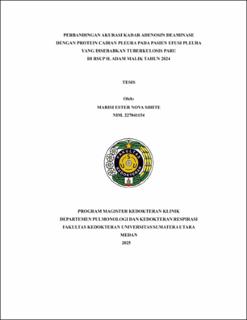Perbandingan Akurasi Kadar Adenosin Deaminase dengan Protein Cairan Pleura pada Pasien Efusi Pleura yang Disebabkan Tuberkulosis Paru di RSUP H. Adam Malik Tahun 2024
Comparison of the Accuracy of Adenosine Deaminase Levels and Pleural Fluid Protein in Patients with Pleural Effusion Caused by Pulmonary Tuberculosis at Adam Malik Hospital in 2024

Date
2025Author
Sihite, Marisi Ester Nova
Advisor(s)
Bihar, Syamsul
Harahap, Okto Mara Fandi
Ashar, Taufik
Metadata
Show full item recordAbstract
Background: Tuberculosis (TB) is a global health issue, with approximately one-third of the world's population infected with Mycobacterium tuberculosis (MTB). Indonesia ranks second in the world for the highest number of TB cases, after India. Tuberculous pleural effusion, an extrapulmonary form of TB, is the second most common case after TB lymphadenitis, with a prevalence of about 4%. Pleural fluid Adenosine Deaminase (ADA) testing has been shown to be an effective, quick, simple, and non-invasive diagnostic tool for TB-related pleural effusion. Additionally, pleural fluid protein plays a role in differentiating tuberculous pleural effusion from other causes. Previous studies have shown good sensitivity and specificity, but no studies have compared the accuracy of ADA levels and pleural fluid protein in Indonesia.
Methods: This study aims to compare the accuracy of Adenosine Deaminase levels and pleural fluid protein in patients with pleural effusion caused by pulmonary tuberculosis at RSUP H. Adam Malik in 2024. This study used a comparative analytical design with a cross-sectional approach. The study was conducted on 35 samples that met the inclusion criteria.
Results: This study demonstrates that the cut-off value for ADA is 43.00 U/L, while the cut-off for pleural fluid protein levels is 4.31 g/dL. ADA testing shows a sensitivity of 99% and specificity of 99%, whereas pleural fluid protein levels exhibit a sensitivity of 83% and specificity of 75%. Although both tests have the same sensitivity, ADA has a higher specificity. In terms of predictive values, ADA shows a Positive Predictive Value (PPV) and Negative Predictive Value (NPV) of 99%, significantly higher than the pleural fluid protein levels with a PPV of 78% and NPV of 80%. The accuracy of the ADA test reaches 99%, while the accuracy of pleural fluid protein levels is only 79%.
Conclusion: This study indicates that ADA testing is more accurate and has higher specificity, PPV, and NPV compared to pleural fluid protein levels, making it a more reliable diagnostic tool for pleural effusion.
Keywords: Cut-Off, Adenosine Deaminase, Pleural Fluid Protein, Accuracy
